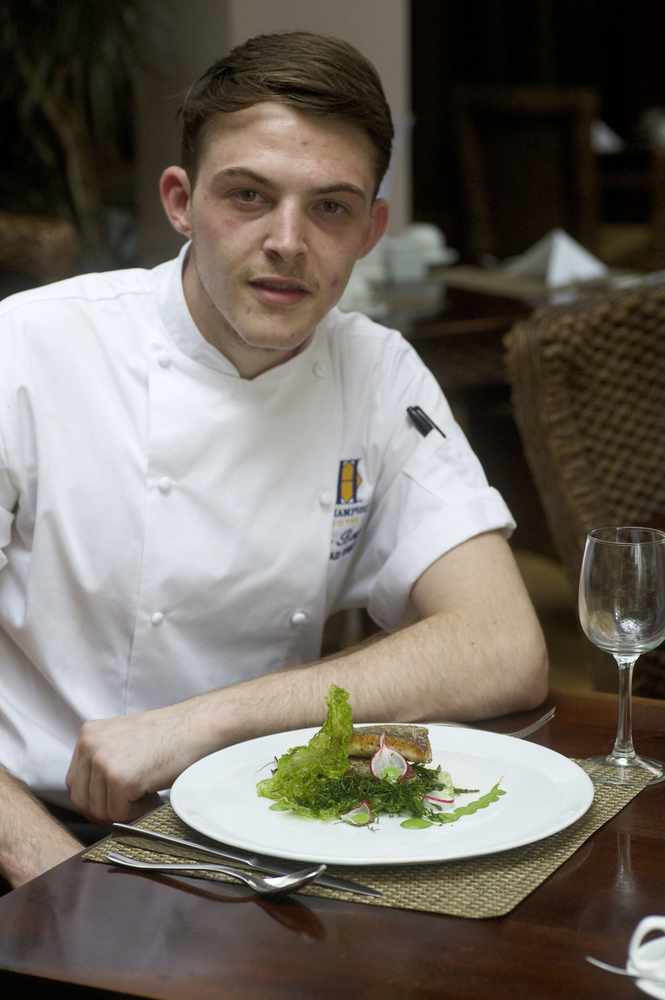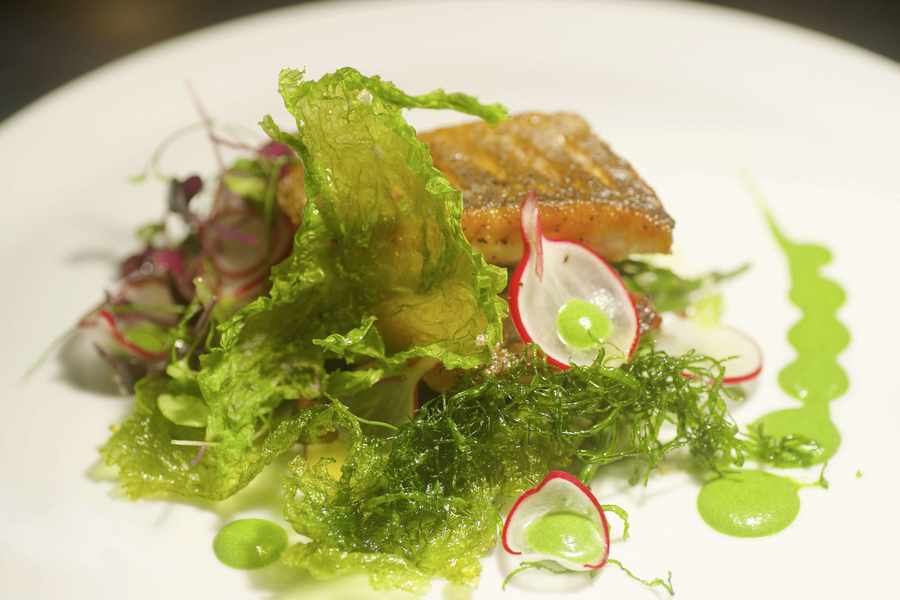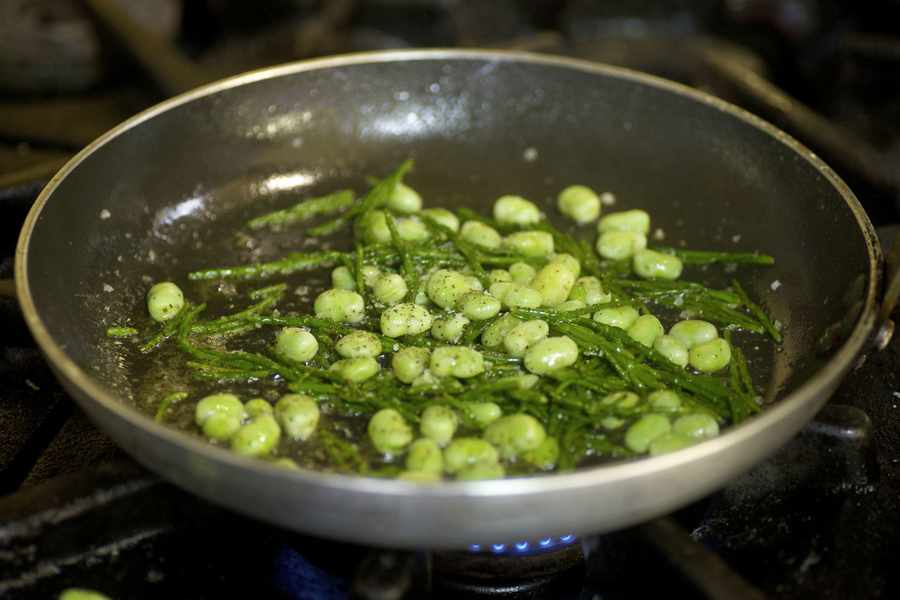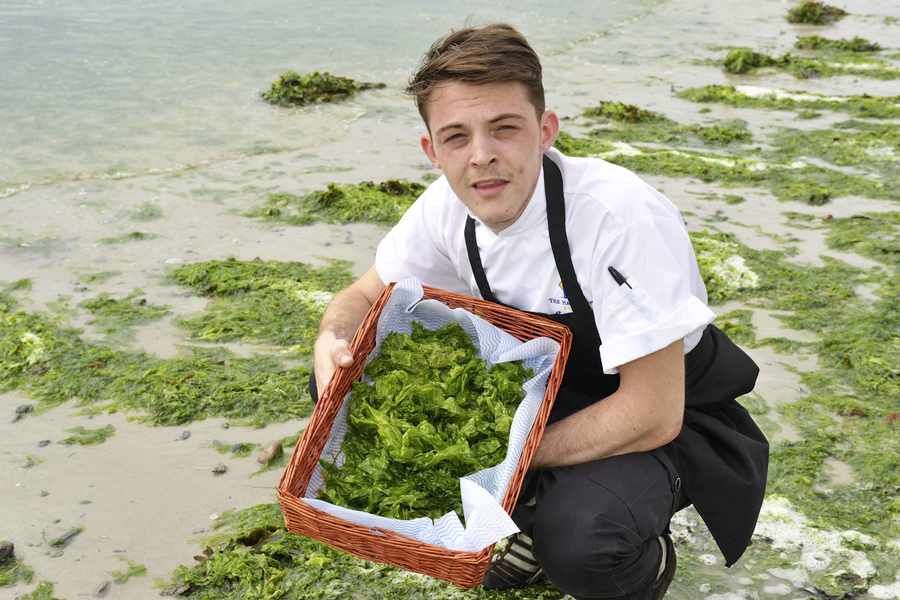- Local chef Joe Baugh has come up with novel approach to tackle sea lettuce problem
- He suggests that Islanders eat the green weed which has blighted St Aubin’s Bay
- Joe said that it ‘tastes of the sea’ and that Islanders could learn to love it
- Would you eat sea lettuce? Take our poll below
THE tonnes of sea lettuce blighting St Aubin’s Bay may have left a bad taste in many Islanders mouths – but for at least one man its a free gourmet goodie.

Joe Baugh, head chef at the Hampshire Hotel in St Helier, said he has been using the slimy green weed on his menus for the past two years and thinks Islanders can learn to love it if they understand its benefits.
The 24-year-old said he forages the ‘stunning’ sea lettuce himself and creates all manner of accompaniments for dishes that are served in the hotel’s restaurant, which has two AA Rosettes for the quality of its food.
Mr Baugh, who trained at Highlands College and has previously worked at the Grand Hotel as well as in France, said it ‘tastes of the sea’ and is great with a multitude of seafood dishes.
He urged home-cooks and top chefs to start using it more to help turn it into a Jersey delicacy.
‘I relish it. I go and pick it myself and use it. Its a local product and it only becomes a nuisance when people don’t know how to use it,’ the former Le Rocquier student said.
‘Its called Nori, the Japanese use it. I’ve been messing around with it for years, using it in purées and emulsions and drying it out. You can use it with a lot of stuff its so versatile.
‘We used it at college and I ate at this Japanese restaurant in Birmingham and it was just stunning. I have used for the last two years at the hotel and its like any other seasonal produce. We don’t use anything that isn’t local.’

Mr Baugh, who collects his sea lettuce from near the Gunsite Café, urged Islanders to experiment with it themselves but said they must ensure that they pick the fresh weed and wash it thoroughly before they eat it.
He added: ‘There is going to be a lot that is rotten on the beach. People should look for the fresh stuff and get it while its wet. The best way to store is to lay it out on trays and you can freeze it. You must wash it really well first.’
Last week ministers called an extraordinary meeting to try to establish a plan to deal with the growing amount of sea lettuce. The details of that meeting are due to be revealed shortly.

The sea lettuce that turns St Aubin’s Bay green could be cultivated and used in fish food, toothpaste or canned goods, a former Environment Minister said in 2012
The radical suggestions came as then Environment Minister Deputy Rob Duhamel told an Environment Scrutiny panel what he thought should be done about the thousands of tons of sea lettuce that regularly cover the bay.
Deputy Duhamel told the panel that the Transport Department’s method of dealing with seaweed – getting heavy machinery to move it to the low-water mark – was not having any effect at all. He suggested that one option was for a seaweed-growing industry to be set up to cultivate the plant matter and sell it on.

‘Algae is a fantastic plant,’ he said. ‘It introduces a revenue-generating opportunity. The pharmaceutical industry uses alginates, they are present in canned foods and they have to be grown somewhere. They could be grown here.’
The Environment Minister added that seaweed was used by eastern countries to make fish food and he explained that he had already been contacted by an Islander who was interested in using the sea lettuce to make pellets that would feed beds of ormers.

Sea Lettuce Puree
- 500g sea lettuce
- 100ml double cream
- ½ garlic clove (infused in cream)
After washing thoroughly, blanch the sea lettuce in salted boiling water for 20-30 seconds, Remove and Immerse in ice water to refresh. Remove and pat dry between two clean cloths. Gently Heat the double Cream with the garlic to just below boiling point, strain and blend with the sea lettuce, season to taste.
Best served with local plaice or sass as a sauce or garnish.
Dried Sea Lettuce
- 1kg of sea lettuce
Pat dry the Lettuce between two clean cloths, place onto baking trays lined with greaseproof paper. Place into an oven on its lowest fan setting for 4-5 hours or best left overnight. Food dehydrators are best for this process, but an oven will work fine.
Remove the lettuce, at this point all the liquid should have evaporated leaving you with brittle, crisp leaves. These can now be blended to make a powder or used as a garnish for fish and shellfish. The powder can be used as a garnish on a plate or as a seasoning in place of salt for cooking fish and shellfish.
Pan roasted local bass, marsh samphire, broad beans, textures of Jersey sea lettuce
- 2 bass fillets
- 100g marsh samphire
- 100g broad beans
- 30g dried sea lettuce
- 30g fried sea lettuce
- 20g sea lettuce puree
- 1 lemon
Blanch your broad beans and samphire in salted, boiling water for 1-2 minutes and refresh in ice water. I used the same water I blanched the sea lettuce in to retain some flavour. Pat dry your bass fillets and season with sea salt flakes, fresh pepper and rapeseed oil. Pre-heat a non stick pan to a medium heat, place the bass fillets skin-side down and hold for twenty seconds to keep the skin in flat contact with the pan, cook until the skin becomes crisp and add butter, turn the fish and remove from the heat, baste with the foaming butter in the pan until a golden colour is achieved. Remove from pan and rest for 1 minute. Pour the excess fat from the pan and add a squeeze of lemon juice, the blanched samphire and broad beans. Season and toss in the bass juices till warm and coated. Let this drain for 1 minute on some kitchen towel.






